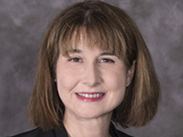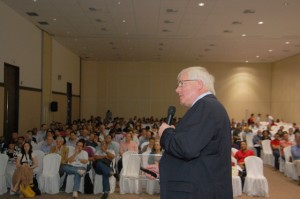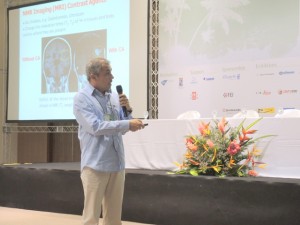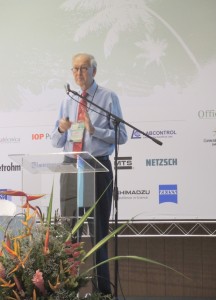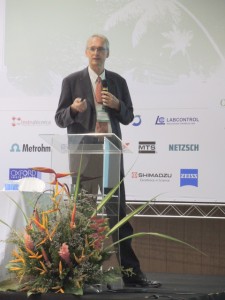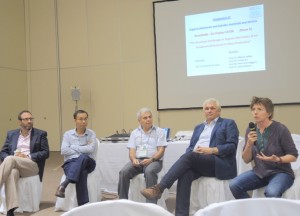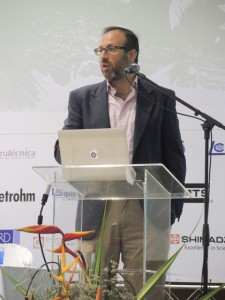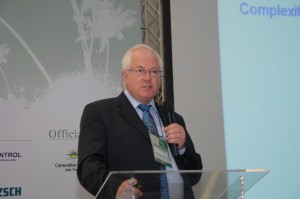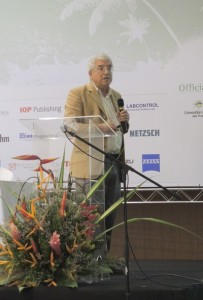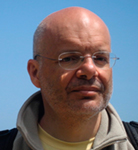
Many shades of blue, red and purple that we can see in the vegetable kingdom (for example, in grapes, raspberries, eggplants and flowers such as violets) are known to be generated by the presence of natural pigments called anthocyanins. However, what makes anthocyanin express in a plant a certain tone of this wide range? This intriguing basic science issue has applications of great interest to the food industry in its quest for healthier dyes from natural components.
A thorough answer will be presented in a plenary lecture of the XVIII B-MRS Meeting by Stefano Baroni, Full Professor of Condensed Matter Theoretical Physics at Scuola Internazionale Superiore di Studi Avanzati (SISSA) – an institution located in Trieste (Italy), dedicated to research and graduate studies in various areas of science. Baroni has been studying that issue, using, mainly, a computational method that considers phenomena occurring at the molecular level over several time scales.
Prof. Stefano Baroni is an internationally renowned Italian scientist who loves to invent and improve computational methods to unveil the properties of matter at the molecular scale and apply them to problems of fundamental and applicative interest. For example, Baroni is one of the principal creators of Density Functional Perturbation Theory (DFPT), a computational tool that allows the study of physical properties of materials that depend on responses to external perturbations. He is also the founder and one the main instigators of the Quantum ESPRESSO, project, one of the most popular open source softwares for quantum materials modeling and calculations at the nanoscale, and founding director of the Quantum ESPRESSO Foundation.
Stefano Baroni obtained a degree in Physics from the Università di Pisa (Italy) in 1978. After that, until 1984, he was a postdoctoral fellow at the École Polytechnique Fédérale de Lausanne (EPFL), in Switzerland. Later, he became Assistant Professor at the Department of Theoretical Physics at the Università degli Studi di Trieste until he joined SISSA in 1988. From 1994 to 1998, he was Director of CECAM, a European center for research in computational sciences and their applications, then based at the École Normale Supérieure de Lyon, in France. Thereafter, until 2003, he served as coordinator in Trieste of the Istitituto Nazione per la Fisica della Materia (INFM). From 2001 to 2008, he was Founding Director of the DEMOCRITOS national simulation center, now part of the Italian CNR. Baroni has been a visiting professor at many institutions around the world, including Université Pierre et Marie Curie (France), Princeton University (USA), University of Minnesota (USA), University of Sydney (Australia), University College London (UK).
See our mini interview with Prof. Stefano Baroni.
B-MRS Newsletter: – We´d like to know more about your scientific work. Please choose one or two of your favorite/ high-impact contributions, briefly describe them, and share the references.
For forty years my research has been motivated by the attempt to solve the fundamental equations that determine the properties of materials at the atomic scale, in the most realistic conditions practically accessible to computational science. While this effort, which I shared with many scientists more talented than me around the world, is having a tremendous impact in many and diverse technologies, as this Conference convincingly witnesses, my own motivation has been, how to say?, a bit “swotty”? Theorists like me strive to understand. Geniuses sometimes understand what they cannot teach or do not care to implement. Ordinary swots have to do, implement, and teach in order to convince themselves they have understood, and this is what I have been doing all my life, like a Renaissance craftsman. I am probably mostly known for density functional perturbation theory [https://doi.org/10.1103/RevModPhys.73.515], a technique that Paolo Giannozzi and I introduced in the late 80s [https://doi.org/10.1103/PhysRevLett.58.1861] and that is now considered the state of the art in the simulation of the vibrational properties of condensed matter. In the late 00s my colleagues and I generalised this technique to account for the dynamical phenomena that are probed in optical spectroscopies [https://doi.org/10.1103/PhysRevLett.96.113001, https://doi.org/10.1063/1.2899649]. This work provided the methodological motivation for me to enter the field of molecular spectroscopy, which eventually led me to study the color of flowers and fruits. The challenge to compute what others believe cannot be computed was also the motivation for me to enter the fascinating field of heat and charge transport in condensed matter, a senile passion I will have the privilege to report on in Symposium S of this conference on September 24 at 9:30 [https://doi.org/10.1038/nphys3509, https://doi.org/10.1038/s41598-017-15843-2, https://doi.org/10.1038/s41467-019-11572-4, https://doi.org/10.1103/PhysRevLett.122.255901, https://doi.org/10.1038/s41567-019-0562-0].
B-MRS Newsletter: – The subject of the talk aroused our curiosity. Could you tell us what led you to study these pigments? Does it have to do with industrial interest? With the search for fundamental answers? With the application of a new methodology?
As mentioned before, I was drawn to molecular spectroscopy while seeking useful applications for a new computational method that my collaborators and I had devised to deal with dynamical perturbations to quantum-mechanical systems. Ask around what would be the most important application of molecules absorbing light, and many would answer: “solar cells to produce clean, inexhaustible, energy”. So we went, and we were induced into the wrong thinking that efficient and inexpensive solar cells could be manufactured “using fruit juice” (i.e. using anthocyanins as the light-absorbing element of a photovoltaic device). It soon became clear that while the principle per se is not wrong (in fact, organic solar cells based on it are routinely assembled and used for educational purposes https://www.teachengineering.org/activities/view/uoh_organic_activity1, https://education.mrsec.wisc.edu/titanium-dioxide-raspberry-solar-cell/) the stability and efficiency of the resulting device are far too poor for industrial purposes. Meanwhile, our work attracted some attention, and I was invited to some important meetings on solar energy. On one occasion, I declined the invitation knowing that our work could not have a real impact in the field. The organisers flatteringly insisted, and I finally accepted under the condition that I would not talk of solar energy, but of the color of fruits and flowers, which had meanwhile started to arouse my curiosity. A few months later I was approached by a representative of a head-hunting company who, seeking an expert in the molecular simulation of natural dyes on behalf of a major multinational food manufacturer, had stumbled across the abstract of my talk. When I received the telephone call I thought it was a prank and I almost hung up on her. I resisted the impulse, and that was the beginning of an exciting five-years adventure in industrial research, which I never thought I would have lived and whose story I will tell in Balneário Camboriú …
For more information on this speaker and the plenary talk he will deliver at the XVIII B-MRS Meeting, click on the speaker’s photo and the title of the lecture here https://www.sbpmat.org.br/18encontro/#lectures.

